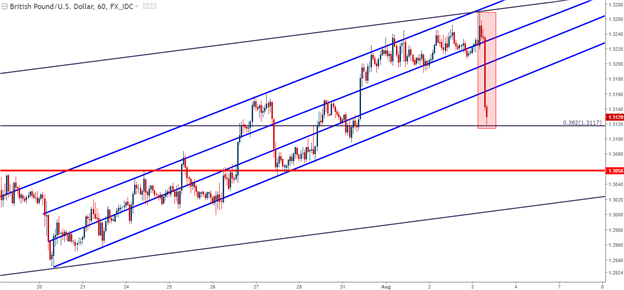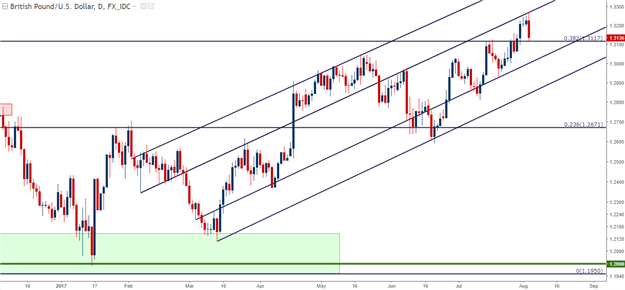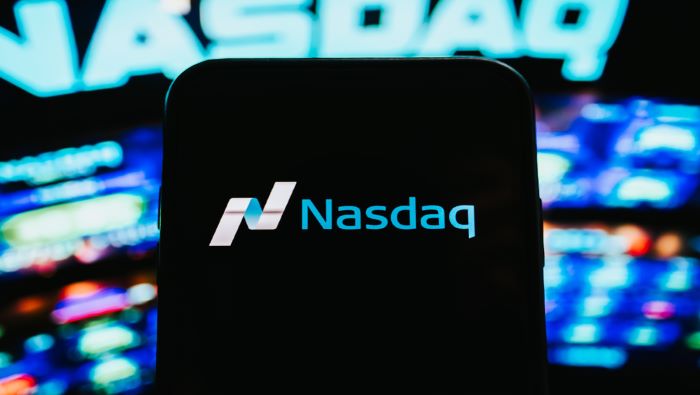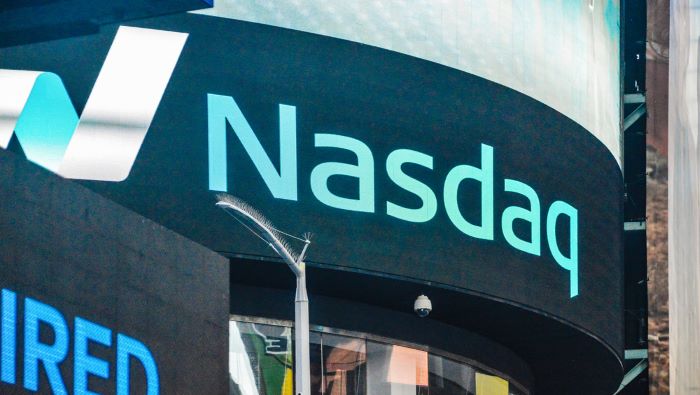Talking Points:
- This morning brought the Bank of England’s Super Thursday to markets: As has become usual, the BoE took a dovish outlook to markets; but within the minutes from this morning’s meeting was a warning that rate hikes may be in the not-too-distant future.
- The British Pound traded down from fresh 2017 highs on this morning’s BoE outlay. But support has begun to show around a key area: Is this a full-scale reversal of the bullish move, or but a blip in the bullish trend?
- If you’re looking for trade ideas, please check out our Trading Guides. And if you’re looking for shorter-term trade ideas, please check out our IG Client Sentiment.
To receive James Stanley’s Analysis directly via email, please sign up here.
At this morning’s Bank of England rate decision, the Monetary Policy Committee voted 6-2 to hold rates flat at .25% while also cutting growth forecasts for the next year and a half. This would be fewer dissenting votes than what was seen at the last BoE rate decision in June when three votes showed up in favor of hiking rates. That previous vote, of course, was in response to the rising inflation that’s currently showing in the British economy, and within the meeting minutes from today’s rate decision, it appears as though the Bank of England is trying to proactively address this a potential issue.
GBP/USD Hourly: Cable Breaks Bullish Trend Channel after Dovish BoE

Chart prepared by James Stanley
Within the minutes, the BoE said: “If the economy were to follow a path broadly consistent with the August central projection, then monetary policy could need to be tightened by a somewhat greater extent over the forecast period than the path implied by the yield curve underlying the August projections”.
This sounds very much like a bank warning that rate hikes may be on the way in response to inflation. As we’re currently seeing in Europe, markets won’t necessarily wait around for the Central Bank to wave the white flag on inflation. As inflation begins to rise, markets and investors build-in the expectation that tighter policy options might be on the horizon. This has led to ‘taper tantrum’ scenarios as bond markets that have been bid by Central Banks over the last nine years prepare to lose one of the market’s biggest buyers as inflationary forces begin to show.
But the fact that the ECB has been evasive about this issue has allowed market participants to creatively model future scenarios. This largely expects that the ECB would first exit from stimulus to make policy ‘less loose’, followed by the hiking of rates to further tighten policy. This is likely why we’ve seen that runaway move of strength in the single currency this year, as markets are pricing in a full-scale change at the ECB at some point later in the year. But also within this morning’s meeting minutes is a line that appears as though the BoE wants to ward off any potential taper tantrum scenarios by saying: “All members agreed that any increases in the Bank Rate would be expected to be at a gradual pace and to a limited extent’.
On the chart below, we’re looking at GBP/USD after June’s rate decision with the 5-3 vote.
GBP/USD Four-Hour: Bullish Move Shows Shortly After June Rate Decision (in blue)

Chart prepared by James Stanley
Growth Forecasts
The Bank of England now expects GDP growth for 2017 of 1.7% from a previous 1.9%, while looking for 1.6% in 2018 from a previous expectation of 1.7%. But the Bank of England also said that they expect near-term inflation to remain around 2.75%, which would further squeeze a British consumer that’s largely been using debt to counter the continued rise in prices. The big matter of obfuscation for the BoE appears to be lacking wage growth. While prices are rising, incomes aren’t rising as quickly – and this puts the British consumer in a proverbial ‘hole’ as their cash doesn’t stretch as far as it previously did.
The inflation that we’re currently seeing is in large part due to the ‘sharp repricing’ in the value of GBP around Brexit and the ensuing dovish campaign from the BoE. If the BoE remains dovish, and if the British Pound remains weak, the potential for those inflationary forces to build becomes even greater. So the Bank of England is likely looking for some element of stability in spot rates for GBP in order for inflation to tame. If GBP rises too quickly on the back of a hawkish BoE, well then the bank has a real big quagmire of stalling growth rates; even if inflation is being tempered. If the GBP falls from here, then the potential for even more inflation down the road is even greater, and then the bank has to look at the scenario of hiking rates in a slowing economy that could further choke off growth.
GBP: Blip in the Trend, or Full-Stop Reversal?
At this stage given the technical back-drop, it would appear as though this morning’s drop is more of a pullback in the bullish trend as opposed to a full-scale reversal. Of course, when considering GBP/USD, one must take into account just how incredibly weak the U.S. Dollar has become; so for traders that are looking for complete reversal scenarios in the British Pound, they’d likely want to look for counter-parts that are not USD; such as the Euro or perhaps even the Japanese Yen.
As we came into this morning’s rate decision, GBP/USD had just traded up to fresh 2017 highs. This was largely on the expectation for the BoE to be ‘less dovish’ than their June decision as inflation has remained well-above the BoE’s 2% target; but that did not happen this morning as the bank cut growth forecasts and bullish bets left the British currency.
This morning’s rate decision is very similar to what we saw in April from the European Central Bank. At that point in time, inflation had begun to show to a greater degree in the European economy, and expectations were beginning to rise that the ECB would abandon their massive stimulus outlays in the effort of tempering inflation. But at the press conference accompanying that rate decision, Mario Draghi directly said that stimulus exit had not been discussed, and this brought a quick iteration of weakness to the Euro. EUR/USD was lacking strength for about two weeks, but buyers showed up around prior support to propel the pair higher.
The same type of thing happened at the ECB’s June rate decision: Mario Draghi was asked whether the bank was looking at exiting stimulus, to which he denied. EUR/USD moved down to prior support and, again, propelled higher after another round of USD-weakness took over.
At this morning’s BoE rate decision, Cable sold-off down to a prior level of interest at 1.3117, which is the 38.2% retracement of the ‘Brexit move’ in GBP/USD. From a momentum perspective, the bullish trend channel that’s defined GBP/USD price action for much of the year remains intact.
GBP/USD Daily: 2017 Trend Channel Intact, Support Showing at Prior Resistance

Chart prepared by James Stanley
--- Written by James Stanley, Strategist for DailyFX.com
To receive James Stanley’s analysis directly via email, please SIGN UP HERE
Contact and follow James on Twitter: @JStanleyFX







